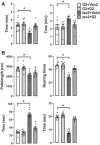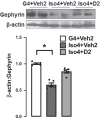Social isolation induces neuroinflammation and microglia overactivation, while dihydromyricetin prevents and improves them
- PMID: 34983568
- PMCID: PMC8724741
- DOI: 10.1186/s12974-021-02368-9
Social isolation induces neuroinflammation and microglia overactivation, while dihydromyricetin prevents and improves them
Abstract
Background: Anxiety disorders are the most prevalent mental illnesses in the U.S. and are estimated to consume one-third of the country's mental health treatment cost. Although anxiolytic therapies are available, many patients still exhibit treatment resistance, relapse, or substantial side effects. Further, due to the COVID-19 pandemic and stay-at-home order, social isolation, fear of the pandemic, and unprecedented times, the incidence of anxiety has dramatically increased. Previously, we have demonstrated dihydromyricetin (DHM), the major bioactive flavonoid extracted from Ampelopsis grossedentata, exhibits anxiolytic properties in a mouse model of social isolation-induced anxiety. Because GABAergic transmission modulates the immune system in addition to the inhibitory signal transmission, we investigated the effects of short-term social isolation on the neuroimmune system.
Methods: Eight-week-old male C57BL/6 mice were housed under absolute social isolation for 4 weeks. The anxiety-like behaviors after DHM treatment were examined using elevated plus-maze and open field behavioral tests. Gephyrin protein expression, microglial profile changes, NF-κB pathway activation, cytokine level, and serum corticosterone were measured.
Results: Socially isolated mice showed increased anxiety levels, reduced exploratory behaviors, and reduced gephyrin levels. Also, a dynamic alteration in hippocampal microglia were detected illustrated as a decline in microglia number and overactivation as determined by significant morphological changes including decreases in lacunarity, perimeter, and cell size and increase in cell density. Moreover, social isolation induced an increase in serum corticosterone level and activation in NF-κB pathway. Notably, DHM treatment counteracted these changes.
Conclusion: The results suggest that social isolation contributes to neuroinflammation, while DHM has the ability to improve neuroinflammation induced by anxiety.
Keywords: Anxiety; Dihydromyricetin (DHM); GABAAR; Microglia; Neuroinflammation; Social isolation.
© 2022. The Author(s).
Conflict of interest statement
The authors declare no conflict of interest and competing interests.
Figures






Update of
-
Social Isolation Induces Neuroinflammation And Microglia Overactivation, While Dihydromyricetin Prevents And Improves Them.Res Sq [Preprint]. 2021 Oct 1:rs.3.rs-923871. doi: 10.21203/rs.3.rs-923871/v1. Res Sq. 2021. Update in: J Neuroinflammation. 2022 Jan 4;19(1):2. doi: 10.1186/s12974-021-02368-9. PMID: 34611661 Free PMC article. Updated. Preprint.
References
-
- Devane CL, Chiao E, Franklin M, Kruep EJ. Anxiety disorders in the 21st century: status, challenges, opportunities, and comorbidity with depression. Am J Manag Care. 2005;11(12 Suppl):S344–S353. - PubMed
-
- Konnopka A, Leichsenring F, Leibing E, König HH. Cost-of-illness studies and cost-effectiveness analyses in anxiety disorders: a systematic review. J Affect Disord. 2009;114(1–3):14–31. - PubMed

